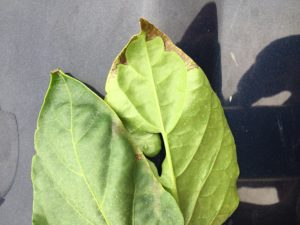Sweet Corn
A few European corn borer (ECB) moths were captured this past week, but numbers are very low, and no map will appear in this edition. It is unclear at this stage if these individuals represent the onset of a second flight. Catches over the upcoming week will clarify the situation with this pest. No new feeding should occur until the second flight arrives.
Growers should continue to scout whorl and pre-tassel stage plantings weekly and consider treating when infested plants exceed 12% in a 50 plant sample. As plantings proceed to the pre-tassel stage, ECB larvae may be found in emerging tassels. It is a good idea to treat individual plantings as they move into the full tassel/first silk stage one time. This eliminates any ECB larvae that have emerged with the tassels as they begin to move down the stalk to re-enter near developing ears.
Useful insecticides for this particular application include synthetic pyrethroids (IRAC Grp 3), spinosyns (including OMRI approved Entrust) IRAC Grp 5), and diamides such as Coragen (IRAC Grp 28) or materials such as Besiege which include the active ingredient in Coragen. Synthetic pyrethroids alone should NOT be used for corn earworm (CEW) protection on silking corn. Control with these materials is very inconsistent.
The highest nightly trap catches of ECB for the week ending 7/03/19 are as follows:
| Denville 1 |
| Flanders 1 |
| Milltown 1 |
| Monroeville 1 |
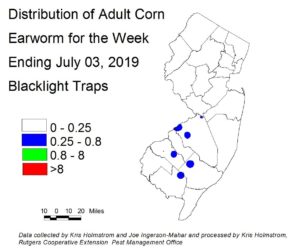 Corn earworm (CEW) moth catches in both trap types are low at this time (see blacklight map at left, and pheromone trap map below at right), although a few pheromone traps are recording somewhat higher numbers. This is the time of the season when CEW activity is at its’ lowest. The overwhelming majority of activity is below Mercer County, with concentrations below Gloucester County. Green areas on the pheromone trap map indicates a 4-5 day silk spray schedule. Blue areas represent a 5-6 day schedule, and white areas
Corn earworm (CEW) moth catches in both trap types are low at this time (see blacklight map at left, and pheromone trap map below at right), although a few pheromone traps are recording somewhat higher numbers. This is the time of the season when CEW activity is at its’ lowest. The overwhelming majority of activity is below Mercer County, with concentrations below Gloucester County. Green areas on the pheromone trap map indicates a 4-5 day silk spray schedule. Blue areas represent a 5-6 day schedule, and white areas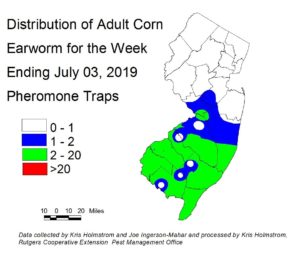 are 6-7 day. There are far fewer CEW pheromone traps than blacklights, and the resulting map has much broader color bands as a result. It should also be noted that the pheromone traps are much more sensitive than blacklights. Therefore, the number of moths caught in pheromone traps required to generate a specific spray interval is much higher than the number caught in blacklight traps. It must be stressed that there is high variability in these catches, and growers should consult with their IPM practitioner on recommended spray schedules.
are 6-7 day. There are far fewer CEW pheromone traps than blacklights, and the resulting map has much broader color bands as a result. It should also be noted that the pheromone traps are much more sensitive than blacklights. Therefore, the number of moths caught in pheromone traps required to generate a specific spray interval is much higher than the number caught in blacklight traps. It must be stressed that there is high variability in these catches, and growers should consult with their IPM practitioner on recommended spray schedules.
The highest nightly trap catches of CEW pheromone trap catches for the week ending 7/03/19 are as follows:
| Pedricktown 21 | Elm 6 | Monroeville 3 | Cedarville 1 |
| Eldora 10 | Beckett 3 | Crosswicks 2 | Chester 1 |
| Woodstown 7 | Green Creek 3 | Dayton 2 | Sparta 1 |
Silking Spray Schedules*:
South – 4-5 days
Central – 5-6 days
North – 6-7 days
*These recommendations are based on regional catches. Adhere to tighter spray schedules if indicated by local trap catches. To repeat: Synthetic pyrethroids alone should NOT be used for corn earworm (CEW) protection on silking corn. Control with these materials is very inconsistent.
Tomatoes
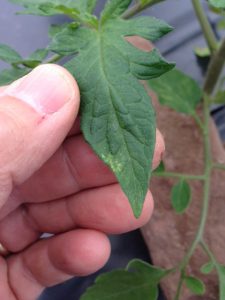 Two-spotted spider mites (TSSM) have begun to appear in some plantings. This pest, if not controlled, can result in significant drying and loss of foliage. Early signs of building infestations are whitish pin spots called a “mite stipple” (see photo at left). Look for these spots on leaves that cup downward and are in the lower canopy. As mites progress, these spots will coalesce into broad yellow areas on the leaflets and will appear higher on the plant. Weekly scouting is necessary for TSSM, and
Two-spotted spider mites (TSSM) have begun to appear in some plantings. This pest, if not controlled, can result in significant drying and loss of foliage. Early signs of building infestations are whitish pin spots called a “mite stipple” (see photo at left). Look for these spots on leaves that cup downward and are in the lower canopy. As mites progress, these spots will coalesce into broad yellow areas on the leaflets and will appear higher on the plant. Weekly scouting is necessary for TSSM, and 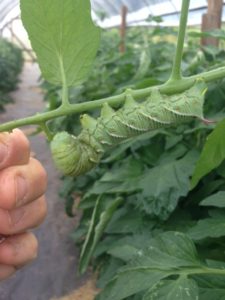 control should be initiated early. Large infestations are difficult to manage. See the Tomato Section of the 2019 Commercial Vegetable Production Guide for recommended miticides. IPM technicians have begun to find tomato hornworms (THW) in some high tunnel tomato plantings this week. These caterpillars (see photo at right), can cause unacceptable levels of damage to foliage and green fruit in high tunnels, while they are rarely a significant problem in the field. If evidence (stripped leaves, droppings or actual hornworms) of these pests are found at multiple sites in the high tunnel, consider control. This can be by hand picking or with insecticides like Coragen (IRAC 28) or Entrust (IRAC 5 – OMRI approved).
control should be initiated early. Large infestations are difficult to manage. See the Tomato Section of the 2019 Commercial Vegetable Production Guide for recommended miticides. IPM technicians have begun to find tomato hornworms (THW) in some high tunnel tomato plantings this week. These caterpillars (see photo at right), can cause unacceptable levels of damage to foliage and green fruit in high tunnels, while they are rarely a significant problem in the field. If evidence (stripped leaves, droppings or actual hornworms) of these pests are found at multiple sites in the high tunnel, consider control. This can be by hand picking or with insecticides like Coragen (IRAC 28) or Entrust (IRAC 5 – OMRI approved).
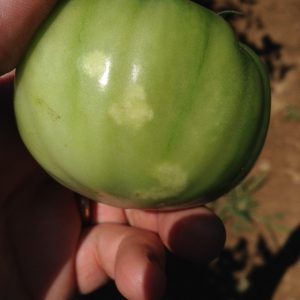 We are entering the period of the growing season when stinkbug activity in tomato fields increases. These insects will feed on fruit, causing the characteristic “cloudy spot” injury (see photo at left). Stinkbug nymphs cannot fly, and will feed extensively on fruit in discrete locations. Often picking crews detect feeding first, due to the volume of fruit they handle. If feeding is increasing or immature stinkbugs are detected in fields, or adults are detected at more than one site in a ten site sample, consider insecticide applications to limit injury. Consult the Tomato Section of the 2019 Commercial Vegetable Recommendations for suggested materials.
We are entering the period of the growing season when stinkbug activity in tomato fields increases. These insects will feed on fruit, causing the characteristic “cloudy spot” injury (see photo at left). Stinkbug nymphs cannot fly, and will feed extensively on fruit in discrete locations. Often picking crews detect feeding first, due to the volume of fruit they handle. If feeding is increasing or immature stinkbugs are detected in fields, or adults are detected at more than one site in a ten site sample, consider insecticide applications to limit injury. Consult the Tomato Section of the 2019 Commercial Vegetable Recommendations for suggested materials.
As yet, no pepper weevils have been captured on traps placed near southern NJ pepper fields.
Bacterial leaf spot infections are occurring with more frequency throughout the state. Dark lesions at the leaf margins, with a water-soaked appearance are typical of this disease (see photo at right). If lesions occur on young leaves that have not fully expanded, the leaves will distort as they mature. Plants will begin to drop infected leaves, resulting in a higher potential for sun scald on the fruit. Growers should consult the Pepper Section of the 2019 Commercial Vegetable Production Guide for suggested treatments, and maintain adequate fertility to the plants to encourage new canopy growth.
Pumpkins and Winter Squash
A cucurbit downy mildew sentinel plot is now established at Snyder Farm in Hunterdon County. This plot, consisting of pumpkin, watermelon, cantaloupe, butternut, acorn, cucumber and kabocha squash will be used to indicate the presence of cucurbit downy mildew in the region, and what crops are affected. The closest documented occurrence of CDM is on cucumber, and comes from Caroline County, MD although this report is now over 7 days old. More recent reports are from no closer than North Carolina. For regional information on this important disease, see the Cucurbit Downy Mildew Forecast webpage: http://cdm.ipmpipe.org/. This weeks’ forecast has NJ at minimal risk risk of infection from sources to our south.
Potato Leafhopper
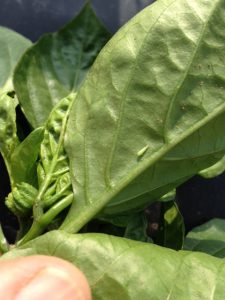 Potato leafhopper (PLH) adults (see photo at left) have appeared in snap beans and other crops over the past two weeks. This pest is a particular problem because it often goes unnoticed until foliar distortion and burn occurs. Once this damage appears in beans and some potato varieties, yields have already been compromised. It is critical that beans be monitored regularly for the presence of PLH. If a sweep net is available, consider treating if more than 100 nymphs and adults are present in 20 sweeps of pre-bloom stage plants. This threshold increases to 250 during bloom and to 500 per 20 sweeps during pod development. If no sweep net is available, check plants in 10 random field locations and consider treating if adults and nymphs are found throughout. Adults are pale green, and will fly out from foliage when disturbed and immediately fly back into the plant canopy. Nymphs are wingless and bright green and may be found on the underside of leaves.
Potato leafhopper (PLH) adults (see photo at left) have appeared in snap beans and other crops over the past two weeks. This pest is a particular problem because it often goes unnoticed until foliar distortion and burn occurs. Once this damage appears in beans and some potato varieties, yields have already been compromised. It is critical that beans be monitored regularly for the presence of PLH. If a sweep net is available, consider treating if more than 100 nymphs and adults are present in 20 sweeps of pre-bloom stage plants. This threshold increases to 250 during bloom and to 500 per 20 sweeps during pod development. If no sweep net is available, check plants in 10 random field locations and consider treating if adults and nymphs are found throughout. Adults are pale green, and will fly out from foliage when disturbed and immediately fly back into the plant canopy. Nymphs are wingless and bright green and may be found on the underside of leaves.
Cole Crops
Reminder: Destroy crop residue!!
As cabbage, kale, etc. plantings exceed their prime harvest, do not wait long to incorporate all residue into the soil. This prevents the crop residue from becoming a nursery area for pests like crucifer flea beetle and diamondback moth larvae.
